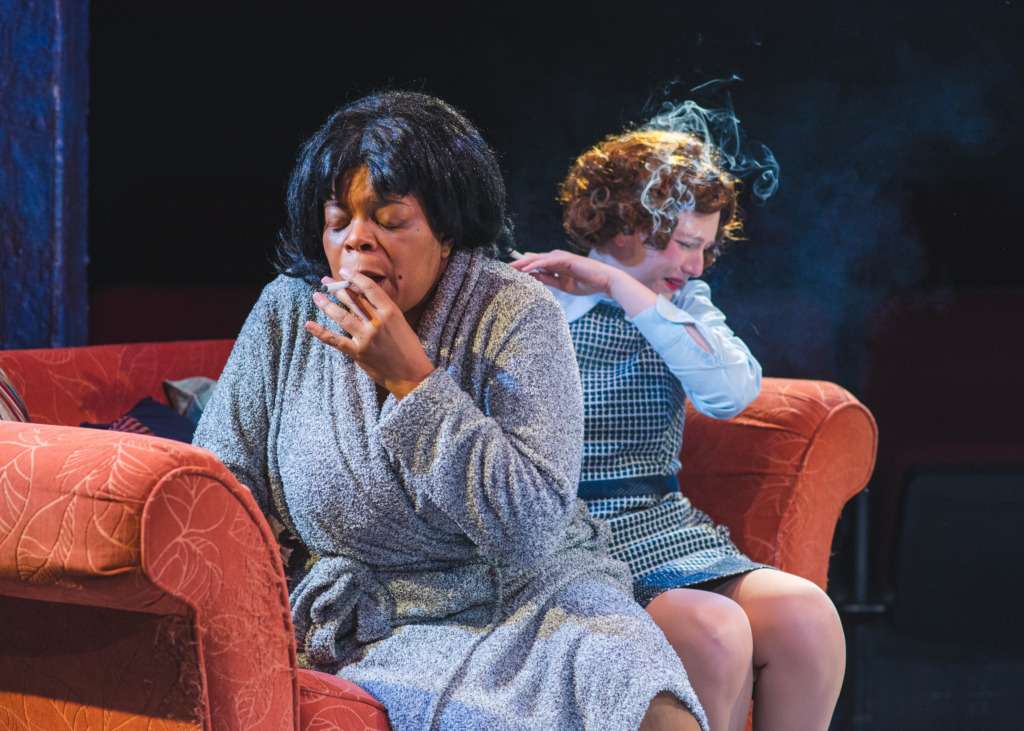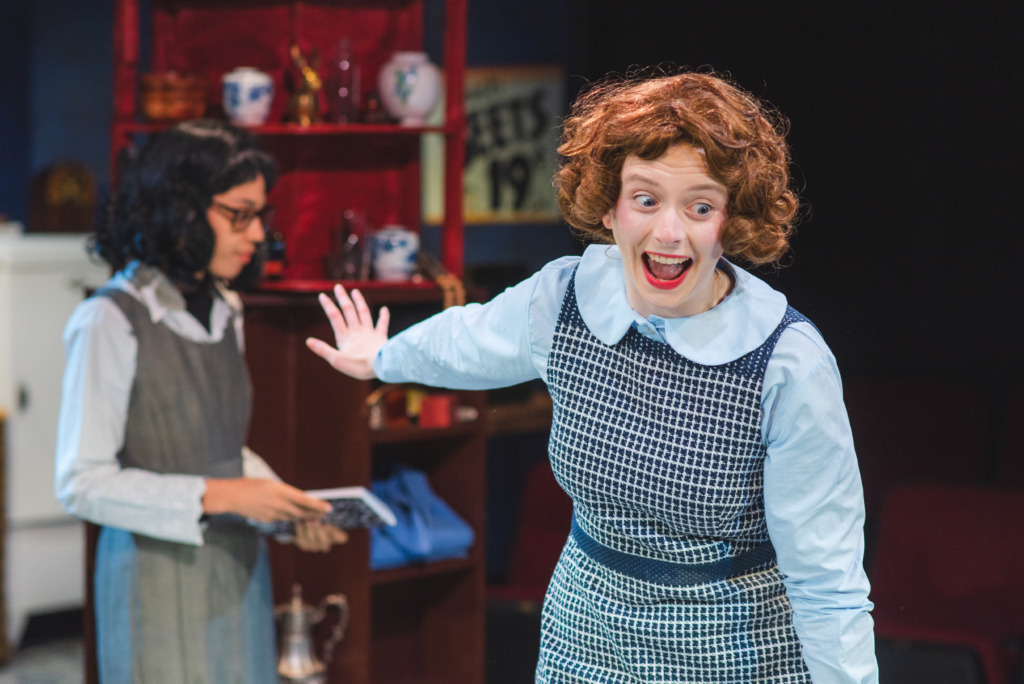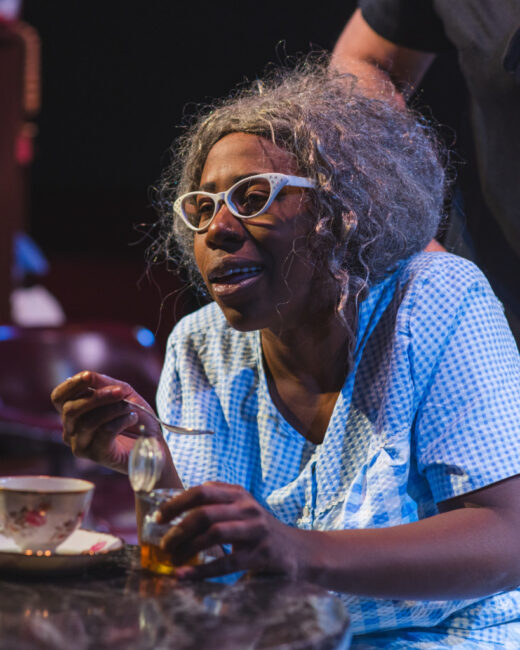Some people were born to speak, others just to listen. And occasionally those of us that listen will report back on what we hear. Form an opinion, as it were. It’s me. I’m a listening opinion-former. And I’m forming an opinion on the current production of The Effect of Gamma Rays on Man-in-the-Moon Marigolds, now playing at The Audrey Herman Spotlighters Theatre through February 4th 2024. The midway point of their 61st season, this Pulitzer Prize-winning drama by Paul Zindel is currently under the direction of Michael Blum, featuring a cast of four, and is most certainly a product of its time.

While there aren’t going to be any brilliant revelations coming out of the play— as it casts mental illness in a disparaging light, showcases family dysfunction without any hope for redemption or atonement, and downplays the importance of women in science (all things that in today’s cancel-happy-culture should have been completely annihilated by now)— you might get a curious evening of emotionally mercurial episodes, spastically interspersed over the boards of Spotlighters Theatre, and all in well under two hours. With a delightfully misleading title, or rather a ‘catchy title of its time to showcase allegory and thematic representation’, The Effect of Gamma Rays on Man-in-the-Moon Marigolds is a toxic mutation of a kitchen sink drama that will most definitely leave you with more questions than answers.
The show’s overall aesthetic seems to fit the bill for the 1963 time stamp of the play’s setting. Set Designer Rob Books and Costume Designer Julia Golbey provide a solid effect in their efforts to capture a lower-class family in Stapleton Heights, Staten Island, New York circa 1963. Though the signs/posters on the wall in the kitchen feel a little off, the trinkets that decorate the shelves are useful…if obscured from three quarters of the audience. (The unique challenge of staging at show at Spotlighters comes as an effective breeze for some and an insurmountable obstacle for others and this production from both a scenic design and directorial movement standpoint falls somewhere in the middle, leaning heavily toward the side of ‘insurmountable obstacle.’)
Blocking in general is a consistent issue for this production. Despite Director Michael Blum being a veteran director in the Spotlighters’ space, his overall blocking for the performance and use of the stage and its many hidden corners just fell short. Even in a seat whose view was primarily unobstructed by the support pillars, there were large sections of the show where things were happening out of sight. One can only imagine how this read to other seats in the house. The other major issue with the show was sound and balancing. While Blum is listed as the show’s sound designer (and it is noted that the audio-voice-over segments reading from the journal are a compulsory part of the script) it’s the execution of these sound clips and their balance that causes the issue. The audio clips of the younger daughter, Tillie, reading from her journal or diary start out loud and are not quite as clear as they could be. And this is only hampered by the lack of volume on the actress when she starts speaking in live time. (Amanda Harris, actress in question, is consistently soft-spoken and unable to be heard throughout much of the performance which is a shame. It’s obvious she’s attempting to play a meek and timid character but the audience still needs to be able to hear her dialogue, meek and timid or not.)

The other issue with Blum’s sound design is the balance of the overall volume. This is really only a factor when there’s music happening late in the second act when the Betty character is on stage without any dialogue. When she picks up the phone to start dialogue, the volume of the music never fades or lowers, making the conversation that Betty is having into the phone almost impossible to hear. Albert Ramer’s Lighting Design does add some really poignant moments and his use of ‘no light’ effects for the storm-driven blackout scene is very, very impressive.
To Blum’s credit, the show does move along at quite a quick pace. This is a good thing considering how the subject matter seems to burble and fester over toxic behaviors. But there are some other overall disconnects in the performance. While the premise of the show appears to be built on familial dysfunction— and older, mentally unwell daughter prone to breaks in sanity and fits, a drunk mother who bemoans the life that could have been, and a timid, misunderstood younger daughter who just wants to focus on science— none of the characters feel as if they have an active relationship with one another. It’s like watching three separate characters deliver monologues in each other’s faces. They’re charged and at times even overwhelmingly emotional, but they lack connectivity and responsiveness to one another and ultimately to the plot as it unfolds.
Kay-Megan Washington gives a mercurial and volatile performance, completely emotionally unstable and while it is arguably one of the most intriguing things to happen in the production, Washington’s approach to the character of Betty, the mother, feels somewhat presentational. Almost as if she’s embodying a caricature of a stereotype of a divorced, drunk, single mother from the 60’s. There’s also something heavily modern about the way Washington delivers her monologues and dialogue, which disrupts the suspension of disbelief when it comes to existing in 1963. To her credit, Washington is the most believable performer on stage when it comes to phone conversations. You really feel as if someone is whispering unheard nothings into her ear via the phone receiver, and her reactions, both physical and vocal, are extremely expressive and indicative of the conversation she’s having that the audience can only hear half of. She also plays a convincing drunk. Not too slurred, not too stumbling, perfectly balanced between the two.

Kaitlyn Ruby, as the older daughter Ruth, is actually an effervescent explosion when she bounces onto the stage. Though it’s incredibly unclear until well into the first act that her character is meant to be mentally unstable. When Ruby initially encounters the audience as Ruth, it reads as an extremely excitable, albeit over-the-top, boy-crazy girl of 1963. When the audience learns later that she’s mentally unwell, has had psychotic breaks and episodes, the bouncy-pluckiness just feels off. This isn’t to denigrate Ruby’s approach as she is beyond vivacious and the only character on stage who can consistently be heard regardless of what she’s saying and at what level of intensity she’s saying it.
The real show-stealer in her cameo and silent moment is India Gregory as Nanny. The character with no lines or dialogue shuffles in once or twice, serving as a nuisance to Betty, simply because she exists. Admittedly, Gregory’s physical manifestation of Nanny is extremely exaggerated, almost to the point of caricature, but she’s so wholly committed to the vacant, slack-jawed gormless facial expressions, mincing, unsteady shuffle on the walker, and overall blank non-existence of the character, that’s its wholly enjoyable.
The show overall is just an odd duck, made more uncertain by its meandering direction, overall disappointing blocking, and lack of projection from the supporting character of Tillie (Amanda Harris.) There are excellent moments— particularly shared between Kaitlyn Ruby’s Ruth and Kay-Megan Washington’s Betty when they’re screaming their recollections of Betty’s father and his Arabber profession. Though again this moment feels like two separate characters experiencing the same moment of narrative, without actually sharing it with one another.
Running Time: 1 hour and 45 minutes with one intermission
The Effect of Gamma Rays on Man-in-the-Moon Marigolds plays through February 4th 2024 at The Audrey Herman Spotlighters Theatre— 817 Saint Paul Street, Baltimore MD. For tickets call the box office at (410) 752-1225 or purchase them online.
